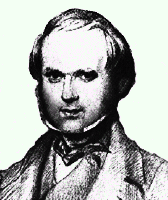
"THE AFFINITIES of all the beings of the same class have sometimes been represented by a great tree. I believe this simile largely speaks the truth. The green and budding twigs may represent existing species; and those produced during each former year may represent the long succession of extinct species . . . The limbs divided into great branches, and these into lesser and lesser branches, were themselves once, when the tree was small, budding twigs; and this connexion of the former and present buds by ramifying branches may well represent the classification of all extinct and living species in groups subordinate to groups . . . From the first growth of the tree, many a limb and branch has decayed and dropped off, and these lost branches of various sizes may represent those whole orders, families, and genera which have now no living representatives, and which are known to us only from having been found in a fossil state . . . As buds give rise by growth to fresh buds, and these, if vigorous, branch out and overtop on all a feebler branch, so by generation I believe it has been with the Tree of Life, which fills with its dead and broken branches the crust of the earth, and covers the surface with its ever branching and beautiful ramifications" (Darwin, 1859).
Also visit our extensive listings on the History of Evolutionary Thought, which recalls the life and work of famous individuals who contributed to our understanding of evolution.
On The Origin Of Species By Means of Natural Selection, Or The Preservation of Favoured Races In The Struggle For Life. By CHARLES DARWIN, M.A., Fellow of the Royal, Geological, Linnaean, etc, Societies; author of Journal of Researches During H.M.S. Beagle's Voyage Round the World. London: John Murray, Albemarle Street, 1859.

|
 The theory of evolution, formalized by Charles Darwin, is as much theory as is the theory of gravity, or the theory of relativity. Unlike theories of physics, biological theories, and especially evolution, have been argued long and hard in socio-political arenas. Even today, evolution is not often taught in primary schools. However, evolution is the binding force of all biological research. It is the unifying theme. In paleontology, evolution gives workers a powerful way to organize the remains of past life and better understand the one history of life. The history of thought about evolution in general and paleontological contributions specifically are often useful to the workers of today. Science, like any iterative process, draws heavily from its history.
The theory of evolution, formalized by Charles Darwin, is as much theory as is the theory of gravity, or the theory of relativity. Unlike theories of physics, biological theories, and especially evolution, have been argued long and hard in socio-political arenas. Even today, evolution is not often taught in primary schools. However, evolution is the binding force of all biological research. It is the unifying theme. In paleontology, evolution gives workers a powerful way to organize the remains of past life and better understand the one history of life. The history of thought about evolution in general and paleontological contributions specifically are often useful to the workers of today. Science, like any iterative process, draws heavily from its history.

